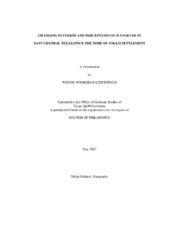| dc.description.abstract | Patterns and perceptions of water use have changed since Anglo settlement in
Texas in the early nineteenth century. Change has not been constant, gradual, or linear,
but rather has occurred in fits and spurts. This pattern of punctuated equilibrium in
water use regimes is the central finding of this dissertation. Water use is examined in
terms of built, organizational, and institutional inertias that resist change in the cultural
landscape. Change occurs only when forced by crisis and results in water management
at an increasing scale. Perception is critical in forcing response to crisis.
Four water use regimes are identified. The agrarian regime was characterized by
individual family and plantation units that were self-sufficient in their water supply.
Water was perceived as abundant, but used sparingly. The agrarian regime began with
Texas’s declaration of independence from Mexico in 1836 and lasted for the remainder
of the nineteenth century. The waterworks regime was characterized by the introduction
of piped water. During this second regime, water was still perceived as abundant, but
was also taken for granted. The crisis forcing the waterworks regime was the need for
better fire protection in cities. The almost constant threat of flood and drought, underscored by the Drought of the 1950s, in conjunction with a demographic shift,
brought about the dam and levee regime. As a consequence of the Drought of the 1950s,
water was for the first time perceived as scarce. We have just entered the groundwater
regime. Recent water legislation and a state supreme court decision in favor of a bottled
water company are putting new emphasis on groundwater sales from rural property
owners to municipal water companies.
Empirical studies supporting this theoretical framework are drawn from the
heretofore unpublished 1868 journal of Pleasant B. Watson, from municipal bond
records in the archives of the Texas Comptroller, from the early history of the
waterworks at Bryan, Texas, from newly discovered records of a levee along the Brazos
River, from an overview of dam and reservoir construction, and from a recent
proliferation of groundwater districts. | en |







